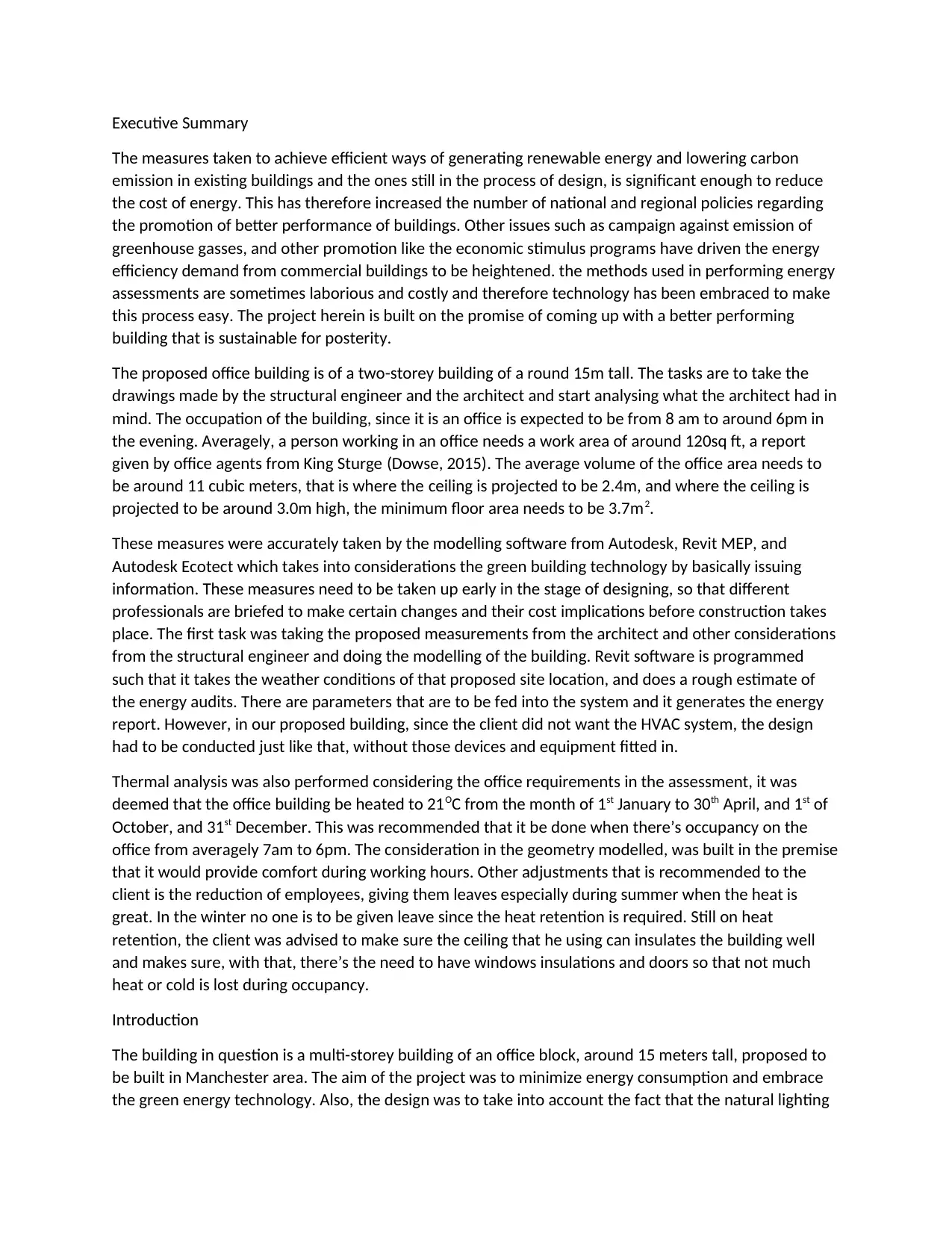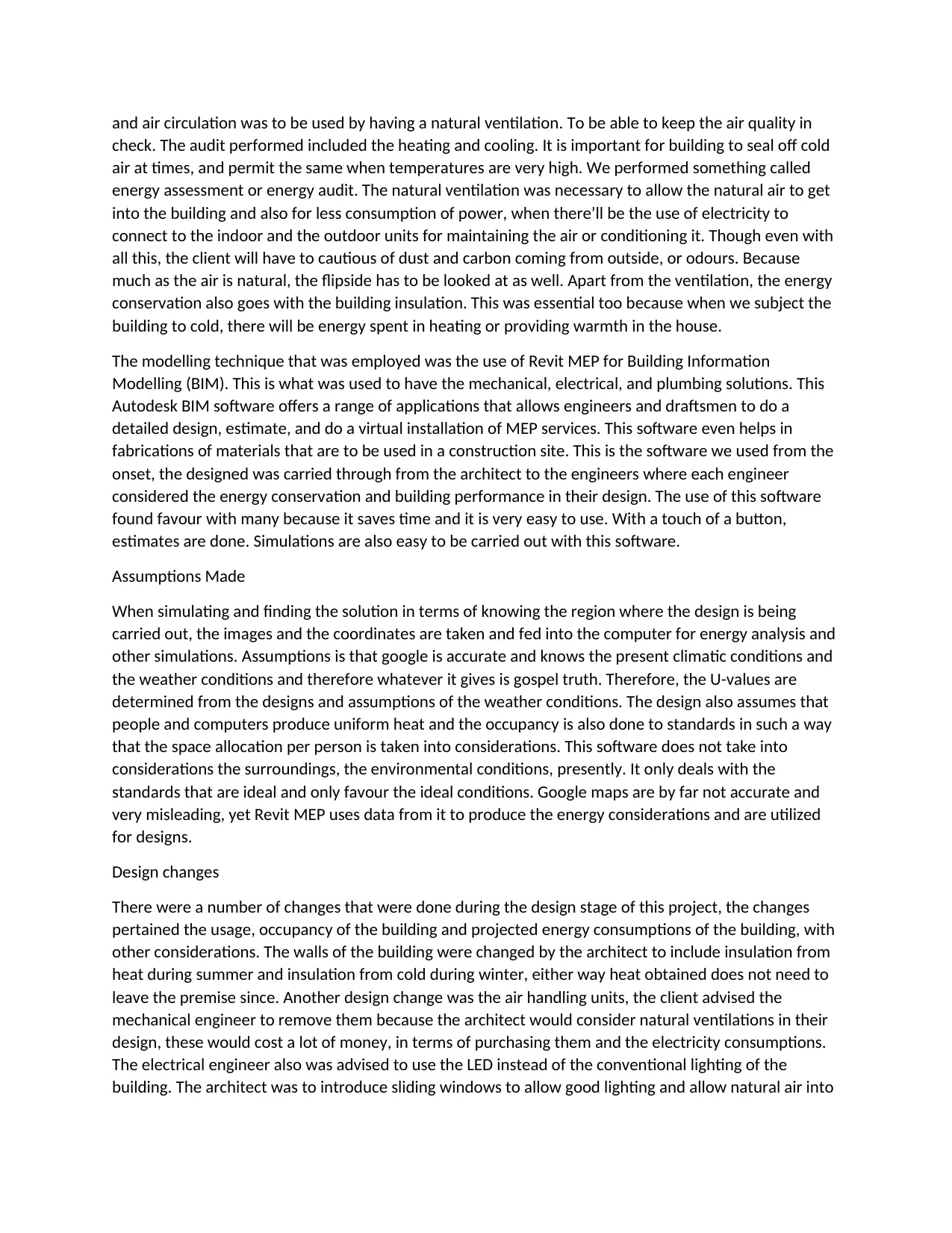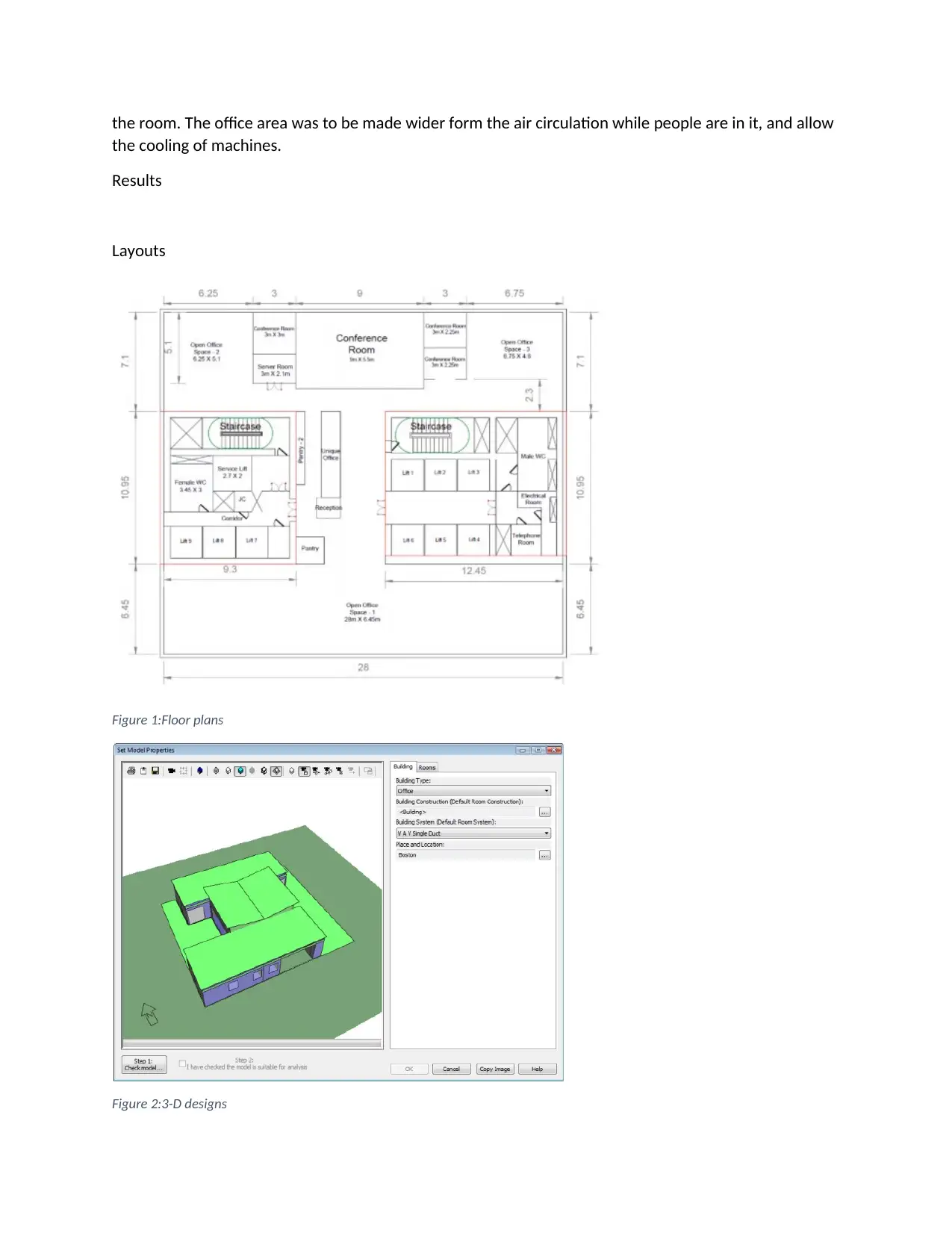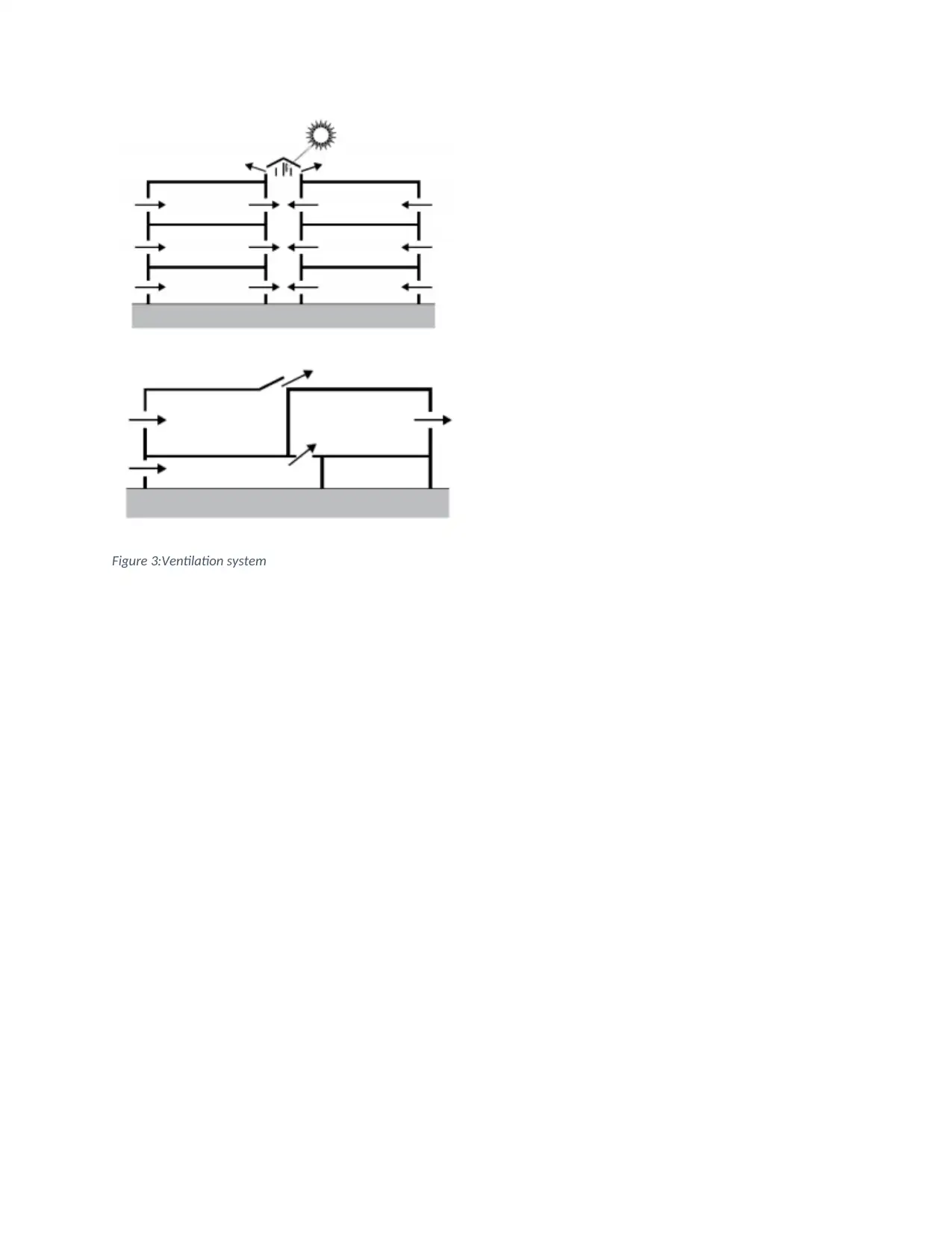ENGT5261: Design Improvements to a Multi-Storey Office Building Design
VerifiedAdded on 2022/12/30
|4
|1434
|71
Report
AI Summary
This report presents design improvements for a multi-story office building, focusing on minimizing energy consumption and embracing green energy technology. The design incorporates natural lighting and ventilation to maintain air quality. Energy assessments, including heating and cooling audits, were performed using Revit MEP for Building Information Modelling (BIM). Design changes included wall insulation, removal of air handling units, LED lighting, and sliding windows. The report details assumptions made during simulations, such as reliance on Google Maps for weather data and uniform heat production from occupants and computers. The results section includes layouts, 3D designs, and ventilation systems, ultimately aiming to create a sustainable and efficient office building.

Executive Summary
The measures taken to achieve efficient ways of generating renewable energy and lowering carbon
emission in existing buildings and the ones still in the process of design, is significant enough to reduce
the cost of energy. This has therefore increased the number of national and regional policies regarding
the promotion of better performance of buildings. Other issues such as campaign against emission of
greenhouse gasses, and other promotion like the economic stimulus programs have driven the energy
efficiency demand from commercial buildings to be heightened. the methods used in performing energy
assessments are sometimes laborious and costly and therefore technology has been embraced to make
this process easy. The project herein is built on the promise of coming up with a better performing
building that is sustainable for posterity.
The proposed office building is of a two-storey building of a round 15m tall. The tasks are to take the
drawings made by the structural engineer and the architect and start analysing what the architect had in
mind. The occupation of the building, since it is an office is expected to be from 8 am to around 6pm in
the evening. Averagely, a person working in an office needs a work area of around 120sq ft, a report
given by office agents from King Sturge (Dowse, 2015). The average volume of the office area needs to
be around 11 cubic meters, that is where the ceiling is projected to be 2.4m, and where the ceiling is
projected to be around 3.0m high, the minimum floor area needs to be 3.7m2.
These measures were accurately taken by the modelling software from Autodesk, Revit MEP, and
Autodesk Ecotect which takes into considerations the green building technology by basically issuing
information. These measures need to be taken up early in the stage of designing, so that different
professionals are briefed to make certain changes and their cost implications before construction takes
place. The first task was taking the proposed measurements from the architect and other considerations
from the structural engineer and doing the modelling of the building. Revit software is programmed
such that it takes the weather conditions of that proposed site location, and does a rough estimate of
the energy audits. There are parameters that are to be fed into the system and it generates the energy
report. However, in our proposed building, since the client did not want the HVAC system, the design
had to be conducted just like that, without those devices and equipment fitted in.
Thermal analysis was also performed considering the office requirements in the assessment, it was
deemed that the office building be heated to 21OC from the month of 1st January to 30th April, and 1st of
October, and 31st December. This was recommended that it be done when there’s occupancy on the
office from averagely 7am to 6pm. The consideration in the geometry modelled, was built in the premise
that it would provide comfort during working hours. Other adjustments that is recommended to the
client is the reduction of employees, giving them leaves especially during summer when the heat is
great. In the winter no one is to be given leave since the heat retention is required. Still on heat
retention, the client was advised to make sure the ceiling that he using can insulates the building well
and makes sure, with that, there’s the need to have windows insulations and doors so that not much
heat or cold is lost during occupancy.
Introduction
The building in question is a multi-storey building of an office block, around 15 meters tall, proposed to
be built in Manchester area. The aim of the project was to minimize energy consumption and embrace
the green energy technology. Also, the design was to take into account the fact that the natural lighting
The measures taken to achieve efficient ways of generating renewable energy and lowering carbon
emission in existing buildings and the ones still in the process of design, is significant enough to reduce
the cost of energy. This has therefore increased the number of national and regional policies regarding
the promotion of better performance of buildings. Other issues such as campaign against emission of
greenhouse gasses, and other promotion like the economic stimulus programs have driven the energy
efficiency demand from commercial buildings to be heightened. the methods used in performing energy
assessments are sometimes laborious and costly and therefore technology has been embraced to make
this process easy. The project herein is built on the promise of coming up with a better performing
building that is sustainable for posterity.
The proposed office building is of a two-storey building of a round 15m tall. The tasks are to take the
drawings made by the structural engineer and the architect and start analysing what the architect had in
mind. The occupation of the building, since it is an office is expected to be from 8 am to around 6pm in
the evening. Averagely, a person working in an office needs a work area of around 120sq ft, a report
given by office agents from King Sturge (Dowse, 2015). The average volume of the office area needs to
be around 11 cubic meters, that is where the ceiling is projected to be 2.4m, and where the ceiling is
projected to be around 3.0m high, the minimum floor area needs to be 3.7m2.
These measures were accurately taken by the modelling software from Autodesk, Revit MEP, and
Autodesk Ecotect which takes into considerations the green building technology by basically issuing
information. These measures need to be taken up early in the stage of designing, so that different
professionals are briefed to make certain changes and their cost implications before construction takes
place. The first task was taking the proposed measurements from the architect and other considerations
from the structural engineer and doing the modelling of the building. Revit software is programmed
such that it takes the weather conditions of that proposed site location, and does a rough estimate of
the energy audits. There are parameters that are to be fed into the system and it generates the energy
report. However, in our proposed building, since the client did not want the HVAC system, the design
had to be conducted just like that, without those devices and equipment fitted in.
Thermal analysis was also performed considering the office requirements in the assessment, it was
deemed that the office building be heated to 21OC from the month of 1st January to 30th April, and 1st of
October, and 31st December. This was recommended that it be done when there’s occupancy on the
office from averagely 7am to 6pm. The consideration in the geometry modelled, was built in the premise
that it would provide comfort during working hours. Other adjustments that is recommended to the
client is the reduction of employees, giving them leaves especially during summer when the heat is
great. In the winter no one is to be given leave since the heat retention is required. Still on heat
retention, the client was advised to make sure the ceiling that he using can insulates the building well
and makes sure, with that, there’s the need to have windows insulations and doors so that not much
heat or cold is lost during occupancy.
Introduction
The building in question is a multi-storey building of an office block, around 15 meters tall, proposed to
be built in Manchester area. The aim of the project was to minimize energy consumption and embrace
the green energy technology. Also, the design was to take into account the fact that the natural lighting
Paraphrase This Document
Need a fresh take? Get an instant paraphrase of this document with our AI Paraphraser

and air circulation was to be used by having a natural ventilation. To be able to keep the air quality in
check. The audit performed included the heating and cooling. It is important for building to seal off cold
air at times, and permit the same when temperatures are very high. We performed something called
energy assessment or energy audit. The natural ventilation was necessary to allow the natural air to get
into the building and also for less consumption of power, when there’ll be the use of electricity to
connect to the indoor and the outdoor units for maintaining the air or conditioning it. Though even with
all this, the client will have to cautious of dust and carbon coming from outside, or odours. Because
much as the air is natural, the flipside has to be looked at as well. Apart from the ventilation, the energy
conservation also goes with the building insulation. This was essential too because when we subject the
building to cold, there will be energy spent in heating or providing warmth in the house.
The modelling technique that was employed was the use of Revit MEP for Building Information
Modelling (BIM). This is what was used to have the mechanical, electrical, and plumbing solutions. This
Autodesk BIM software offers a range of applications that allows engineers and draftsmen to do a
detailed design, estimate, and do a virtual installation of MEP services. This software even helps in
fabrications of materials that are to be used in a construction site. This is the software we used from the
onset, the designed was carried through from the architect to the engineers where each engineer
considered the energy conservation and building performance in their design. The use of this software
found favour with many because it saves time and it is very easy to use. With a touch of a button,
estimates are done. Simulations are also easy to be carried out with this software.
Assumptions Made
When simulating and finding the solution in terms of knowing the region where the design is being
carried out, the images and the coordinates are taken and fed into the computer for energy analysis and
other simulations. Assumptions is that google is accurate and knows the present climatic conditions and
the weather conditions and therefore whatever it gives is gospel truth. Therefore, the U-values are
determined from the designs and assumptions of the weather conditions. The design also assumes that
people and computers produce uniform heat and the occupancy is also done to standards in such a way
that the space allocation per person is taken into considerations. This software does not take into
considerations the surroundings, the environmental conditions, presently. It only deals with the
standards that are ideal and only favour the ideal conditions. Google maps are by far not accurate and
very misleading, yet Revit MEP uses data from it to produce the energy considerations and are utilized
for designs.
Design changes
There were a number of changes that were done during the design stage of this project, the changes
pertained the usage, occupancy of the building and projected energy consumptions of the building, with
other considerations. The walls of the building were changed by the architect to include insulation from
heat during summer and insulation from cold during winter, either way heat obtained does not need to
leave the premise since. Another design change was the air handling units, the client advised the
mechanical engineer to remove them because the architect would consider natural ventilations in their
design, these would cost a lot of money, in terms of purchasing them and the electricity consumptions.
The electrical engineer also was advised to use the LED instead of the conventional lighting of the
building. The architect was to introduce sliding windows to allow good lighting and allow natural air into
check. The audit performed included the heating and cooling. It is important for building to seal off cold
air at times, and permit the same when temperatures are very high. We performed something called
energy assessment or energy audit. The natural ventilation was necessary to allow the natural air to get
into the building and also for less consumption of power, when there’ll be the use of electricity to
connect to the indoor and the outdoor units for maintaining the air or conditioning it. Though even with
all this, the client will have to cautious of dust and carbon coming from outside, or odours. Because
much as the air is natural, the flipside has to be looked at as well. Apart from the ventilation, the energy
conservation also goes with the building insulation. This was essential too because when we subject the
building to cold, there will be energy spent in heating or providing warmth in the house.
The modelling technique that was employed was the use of Revit MEP for Building Information
Modelling (BIM). This is what was used to have the mechanical, electrical, and plumbing solutions. This
Autodesk BIM software offers a range of applications that allows engineers and draftsmen to do a
detailed design, estimate, and do a virtual installation of MEP services. This software even helps in
fabrications of materials that are to be used in a construction site. This is the software we used from the
onset, the designed was carried through from the architect to the engineers where each engineer
considered the energy conservation and building performance in their design. The use of this software
found favour with many because it saves time and it is very easy to use. With a touch of a button,
estimates are done. Simulations are also easy to be carried out with this software.
Assumptions Made
When simulating and finding the solution in terms of knowing the region where the design is being
carried out, the images and the coordinates are taken and fed into the computer for energy analysis and
other simulations. Assumptions is that google is accurate and knows the present climatic conditions and
the weather conditions and therefore whatever it gives is gospel truth. Therefore, the U-values are
determined from the designs and assumptions of the weather conditions. The design also assumes that
people and computers produce uniform heat and the occupancy is also done to standards in such a way
that the space allocation per person is taken into considerations. This software does not take into
considerations the surroundings, the environmental conditions, presently. It only deals with the
standards that are ideal and only favour the ideal conditions. Google maps are by far not accurate and
very misleading, yet Revit MEP uses data from it to produce the energy considerations and are utilized
for designs.
Design changes
There were a number of changes that were done during the design stage of this project, the changes
pertained the usage, occupancy of the building and projected energy consumptions of the building, with
other considerations. The walls of the building were changed by the architect to include insulation from
heat during summer and insulation from cold during winter, either way heat obtained does not need to
leave the premise since. Another design change was the air handling units, the client advised the
mechanical engineer to remove them because the architect would consider natural ventilations in their
design, these would cost a lot of money, in terms of purchasing them and the electricity consumptions.
The electrical engineer also was advised to use the LED instead of the conventional lighting of the
building. The architect was to introduce sliding windows to allow good lighting and allow natural air into

the room. The office area was to be made wider form the air circulation while people are in it, and allow
the cooling of machines.
Results
Layouts
Figure 1:Floor plans
Figure 2:3-D designs
the cooling of machines.
Results
Layouts
Figure 1:Floor plans
Figure 2:3-D designs
⊘ This is a preview!⊘
Do you want full access?
Subscribe today to unlock all pages.

Trusted by 1+ million students worldwide

Figure 3:Ventilation system
1 out of 4
Related Documents
Your All-in-One AI-Powered Toolkit for Academic Success.
+13062052269
info@desklib.com
Available 24*7 on WhatsApp / Email
![[object Object]](/_next/static/media/star-bottom.7253800d.svg)
Unlock your academic potential
Copyright © 2020–2025 A2Z Services. All Rights Reserved. Developed and managed by ZUCOL.





